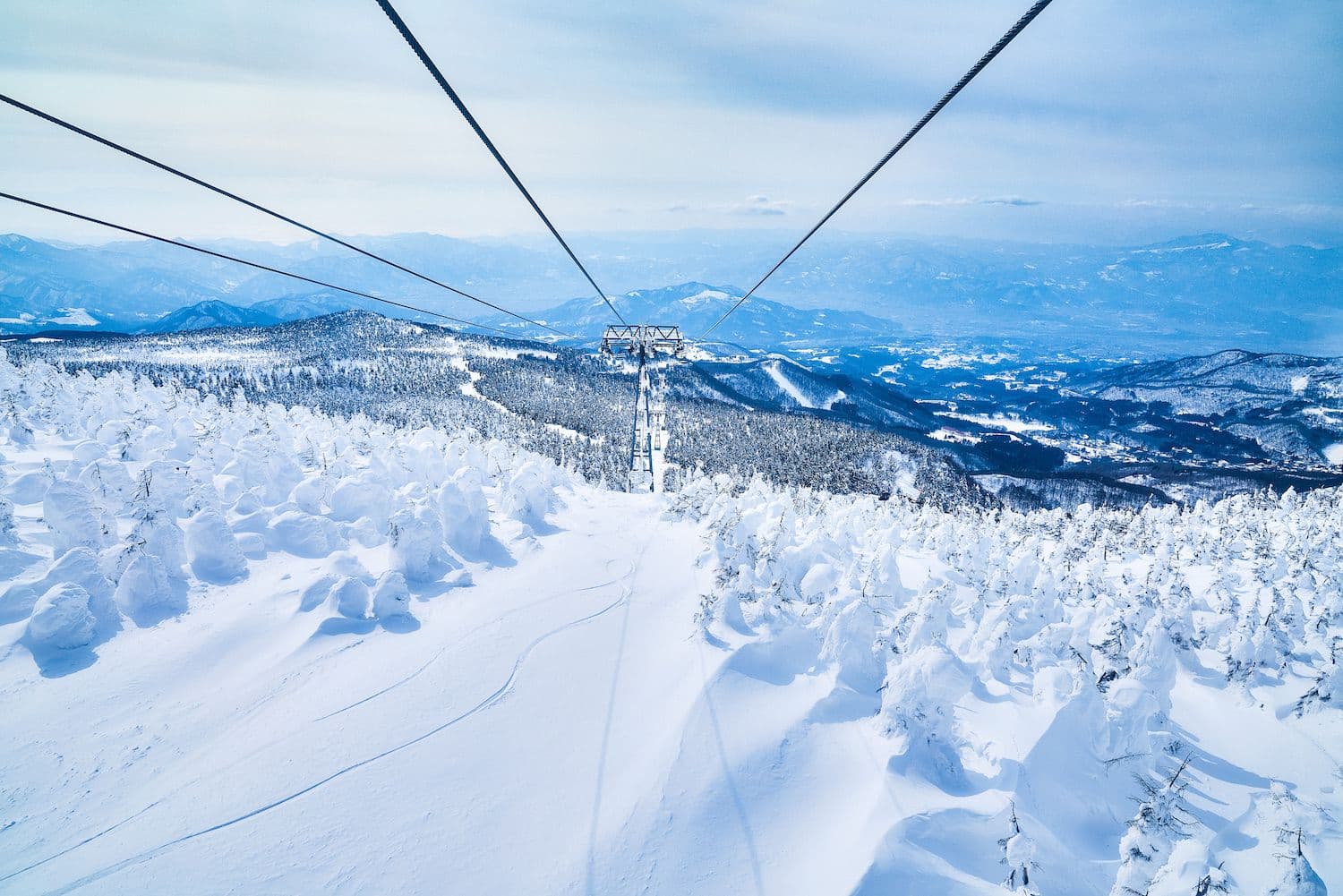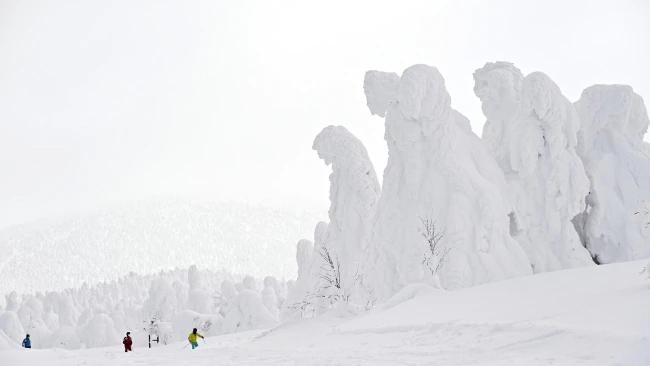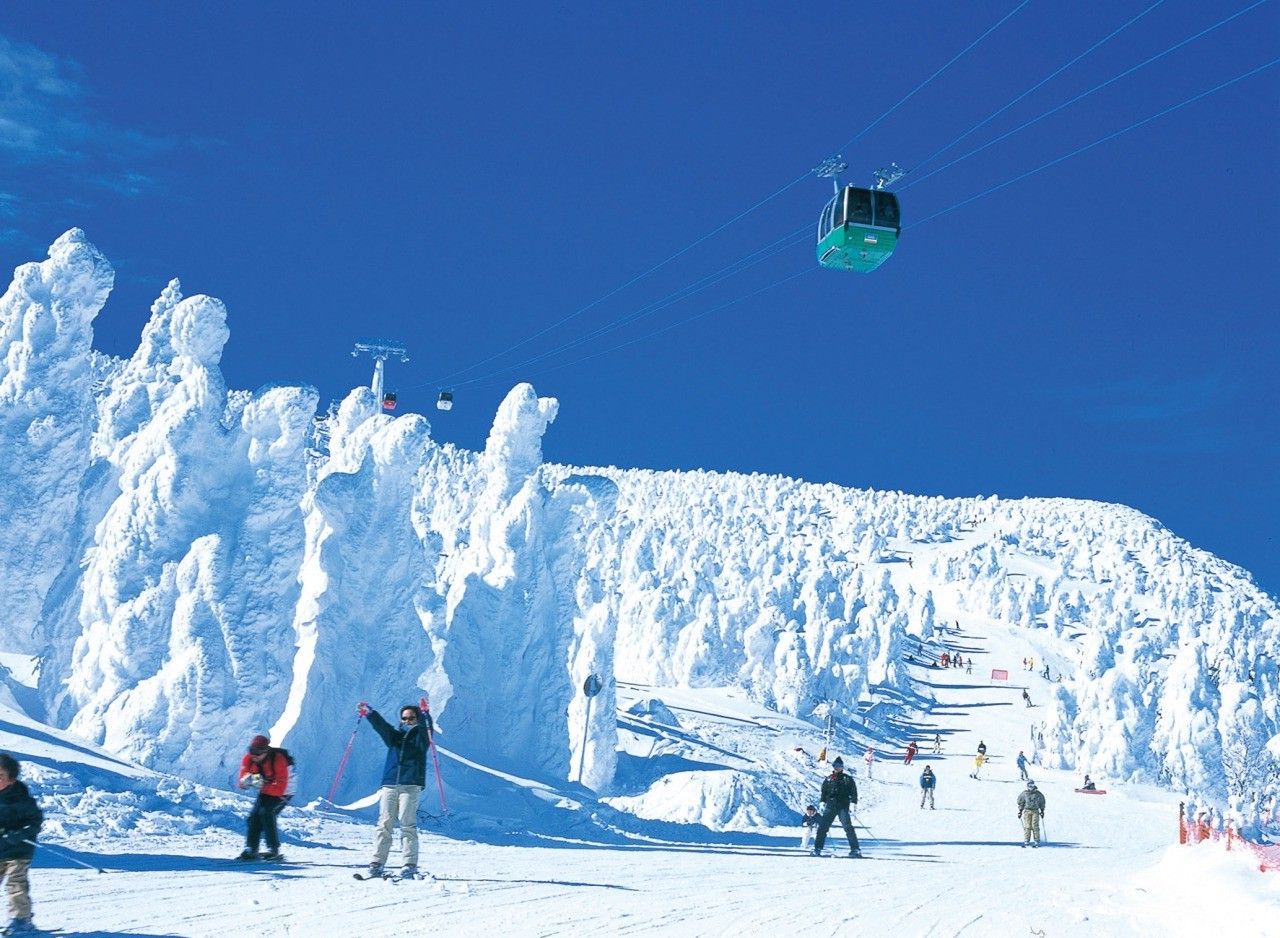Zao Onsen
Where Snow Monsters Meet Champagne Pow

蔵王温泉
A Snow-Monster Classic
Roll into Zao Onsen and the first thing you notice is the steam. It curls up from street-side drains, wafts from wooden bathhouses, and carries the faint tang of sulphur. This is no prefab ski village — Zao is one of Japan’s oldest onsen towns, a place where hot-spring culture is just as important as the skiing. Here, the mountains are alive in more ways than one.
Once you clip in, the tone changes. The resort sprawls over multiple faces, with lifts connecting long cruisers, steeper fall lines, and meandering forest trails. And at the top? The Juhyo — better known to visiting skiers as “snow monsters” — rime-covered trees sculpted into otherworldly shapes by fierce Siberian winds and constant snowfall. Skiing among them is like weaving through a frozen army. On sunny days they sparkle; in storms they loom like ghosts.

The vibe here is different from Hokkaido’s high-traffic hotspots. While weekends bring Yamagata locals in force, midweek it can feel downright spacious. There’s no rush-to-the-rope-drop madness — just the quiet shuffle of boots on wooden steps, the soft swish of powder turns, and the hiss of steam rising from the streets below.
And when the day’s turns are done, the après is pure Japan. No neon clubs or booming bass — just lantern-lit alleyways, the clink of sake cups, and the deep sigh of muscles meeting mineral-rich hot water. Zao is less about all-night parties and more about all-day riding followed by all-evening soaking.
Resort Stats
- Vertical881m (1661m → 780m)
- Snowfall~12m
- Terrain 50% 30% 20%
- Tree Riding
- Lift Pass$32
- Liftsropeways, gondolas, the lot
- Crowds
- Out of BoundsLimited / ski patrol enforced
- Night Skiing
- Family Friendly
- Trails57
- Skiable Area~305ha
- VibeTraditional, mellow, charming
Trail Map

Powder & Terrain
The snow in Zao is a mixed bag — and that’s not a bad thing. When the Siberian express pushes cold air down from the continent, the top lifts get coated in light, dry Japow that rivals anywhere in Honshu. Drop in early from the top ropeway and you can score knee-deep turns through spaced-out glades or alongside the snow monsters themselves.
Mid-mountain, things mellow. Runs get longer and more open, perfect for linking high-speed carves or cruising with friends who might not be as powder-obsessed. These zones hold snow well, though a warm spell can bring heavier conditions lower down. On storm days, sticking to sheltered tree runs off the Omori and Paradise quads can give you consistent visibility and soft, re-settable snow.

The lift system is extensive. Two ropeways, multiple gondolas, and a web of quads and doubles make it possible to ski all day without retracing too many lines. The gear isn’t the newest, but it works — and more importantly, it spreads people out. Even on a Saturday, if you avoid the main beginner arteries, you’ll still be sniffing out untouched snow after lunch.
Tree skiing here is playful rather than extreme. The pitch isn’t intimidating, but the scenery is magic. Between the trunks you’ll find little hits, mini-spines, and soft rolls to launch from. Backcountry is tightly regulated — duck a rope and you’ll likely have ski patrol on your tail — but there are sanctioned side-pockets and natural halfpipes that feel off-piste without the risk of getting your pass pulled.
Local tip? Start at the top ropeway first thing. Not only do you get first dibs on the upper snowfields, but you also beat the photo-hungry tourists headed up just to snap the snow monsters. By late morning, shift to quieter sectors like Yokokura for sneaky fresh lines.
Who's it for?
Zao is a paradise for upper intermediates who want to mix powder hunting with long, leg-burning cruisers. The beginner terrain is excellent — wide, forgiving, and scenic — which makes it a great option for mixed-ability groups.
Advanced riders will love the snow-monster zones and tree sections, especially on midweek storm cycles. If you’re an expert freerider used to big-mountain exposure, you might find the regulated off-piste rules frustrating — but you’ll still be rewarded with long fall-line runs and playful side-hits.
And for anyone who loves combining skiing with cultural immersion, this is hard to beat. You’ll ride, soak, and eat like a local — often without another foreigner in sight outside the busier holidays.
Accommodation
One of Zao’s charms is its lodging variety. The village is packed with family-run ryokans — the kind where you pad around in slippers, dine on multi-course kaiseki feasts, and soak in steaming rotenburo (outdoor baths) while snowflakes melt on your skin. Many are ski-in, ski-out or just a short walk to the lifts.
Mid-range hotels offer western-style beds but keep the traditional touches — tatami mats, sliding shoji doors, and in-house onsens. They’re ideal if you want comfort without losing that Japanese feel.

Budget travelers aren’t left out. There are pensions and guesthouses a little further from the slopes, often with shared baths and hearty home-cooked meals. Some offer shuttle service to the lifts. These spots are perfect for long stays — you’ll be welcomed like family by the second night.
Food & Après
Food here is an extension of the onsen culture — slow, warming, and soul-satisfying. Traditional ryokan dinners often feature Yamagata beef, fresh river fish, and seasonal vegetables simmered in hotpots. Mid-day on the mountain, you can duck into a slope-side shack for a steaming bowl of miso ramen or curry rice before heading back into the snow.
Après is subdued. There’s no nightclub strip — just a handful of izakaya, a craft beer bar or two, and maybe a karaoke lounge if you’re hunting for it. Most riders prefer to linger over dinner, sip a glass of sake, and then slip into the onsen to let the day’s turns settle into memory.
If you want a truly local experience, wander the back streets and follow your nose — the little mom-and-pop eateries hidden down alleyways are where you’ll find the best hotpots and grilled skewers.
Getting There
Zao is surprisingly easy to reach for a Tohoku resort. From Tokyo, take the Yamagata Shinkansen to Yamagata Station (about 2.5 hours), then hop on a 40-minute bus to the resort. If you’re flying, Yamagata Airport is the closest, with a similar transfer time.
Driving is an option, but roads can get seriously icy in mid-winter. If you’re not used to snow driving, stick to the train and bus combo — it’s stress-free and reliable. If you do rent a car, make sure it’s fitted with winter tires or carry chains.
Japow Travel Tips
- Lift hours: Typically 8:30 – 17:00, with night skiing until 21:00 in select areas.
- Avalanche safety: Off-piste is restricted — always check where you’re allowed to ride.
- Snow patterns: Best snow is mid-January to mid-February. Late season brings great views but softer snow.
- Language: Some English spoken, especially in larger hotels, but learning a few phrases goes a long way.
- Unique quirk: The snow monsters — best viewed in the blue-hour light of early evening.
- Nearby resorts: Tengendai and Kaminoyama Onsen make for fun side trips.
Verdict — Powder with Character
Zao Onsen isn’t trying to be the deepest, steepest, or wildest resort in Japan — and that’s exactly its strength. It offers a balance you don’t often find: enough Japow to keep you grinning, terrain variety to keep you busy for days, and a cultural experience that’s pure old-school Japan.
Here, the joy isn’t just in the turns — it’s in the walk back to your ryokan through snowy streets, the steam curling up into the night air, and the quiet satisfaction of knowing you’ve found something special.